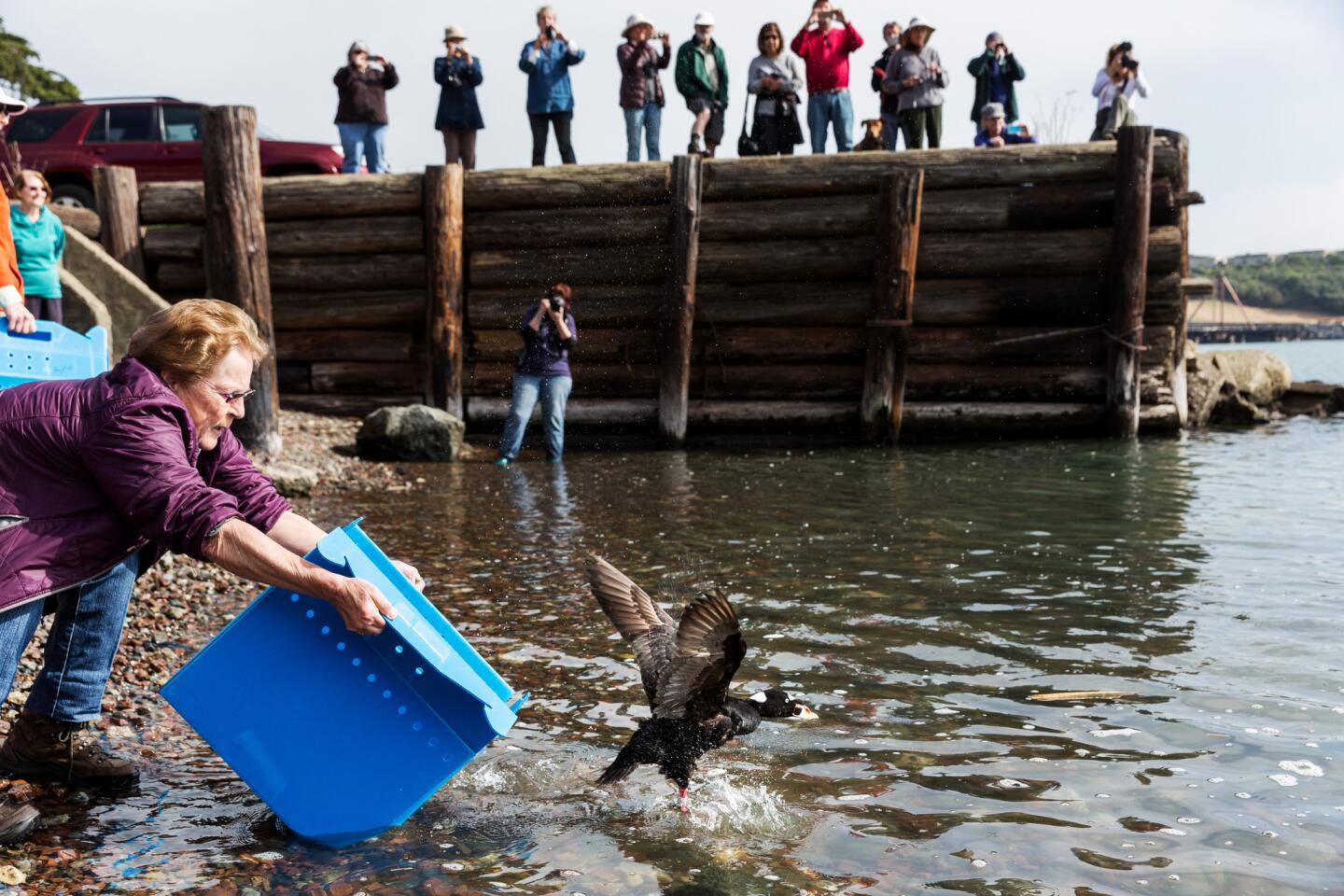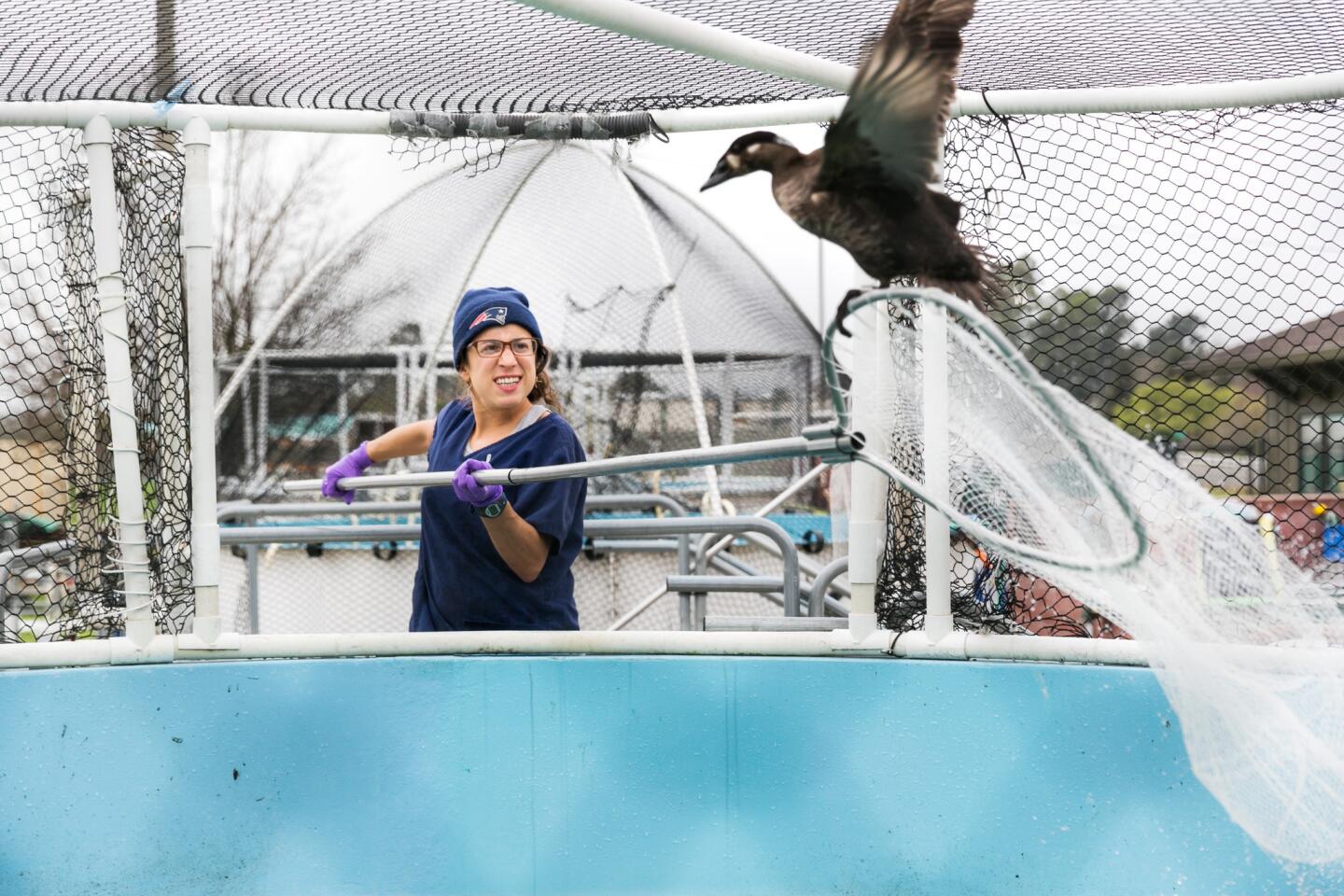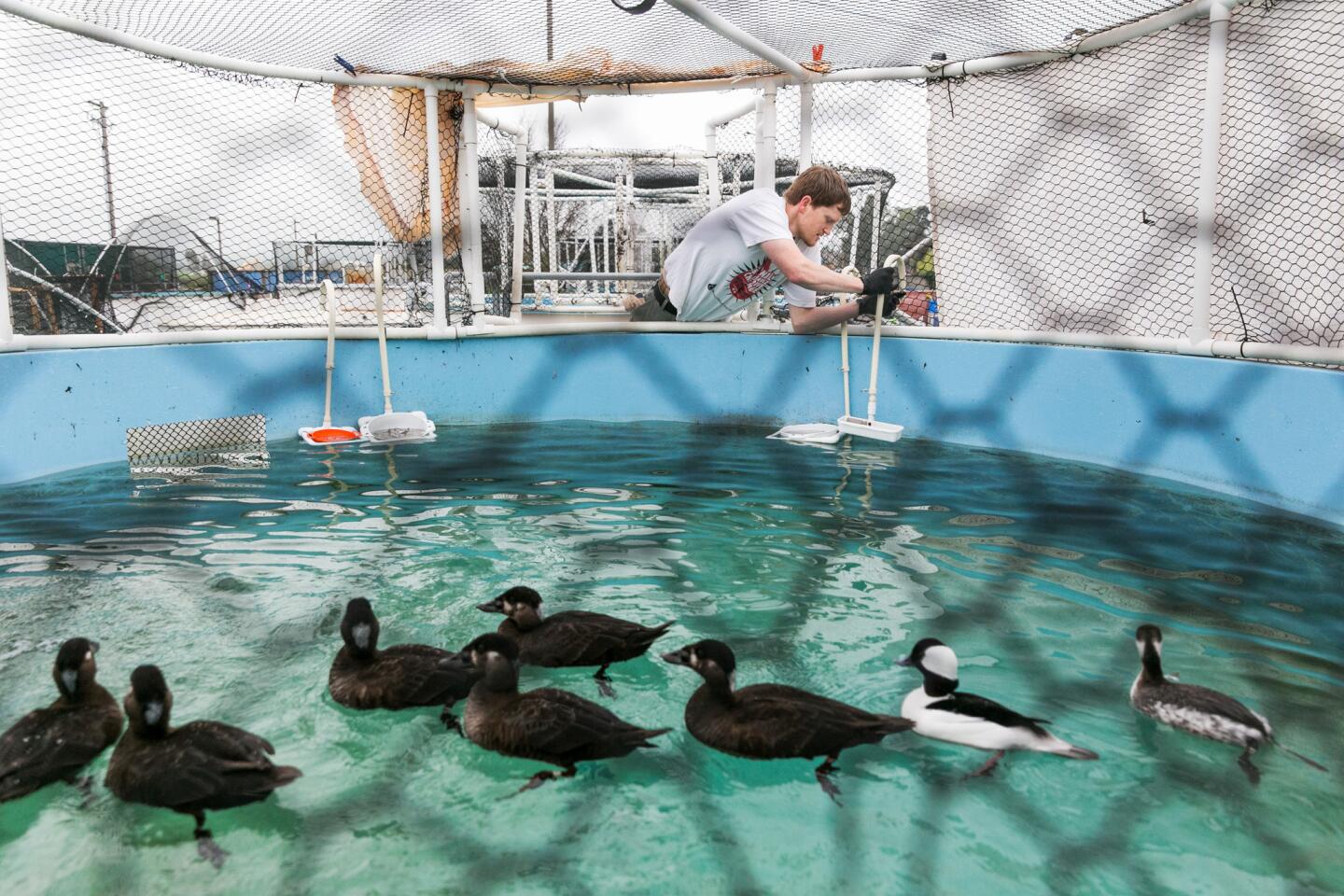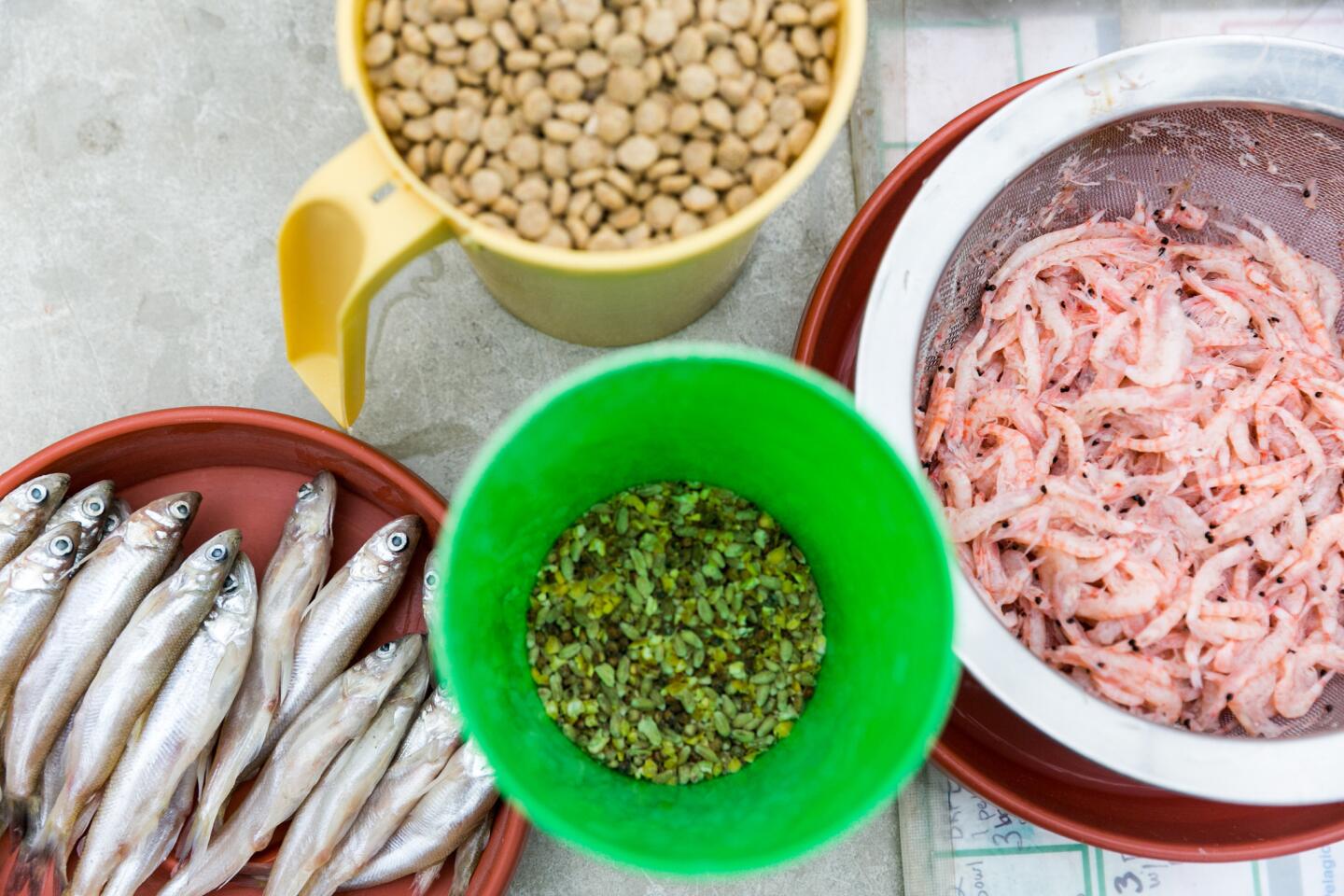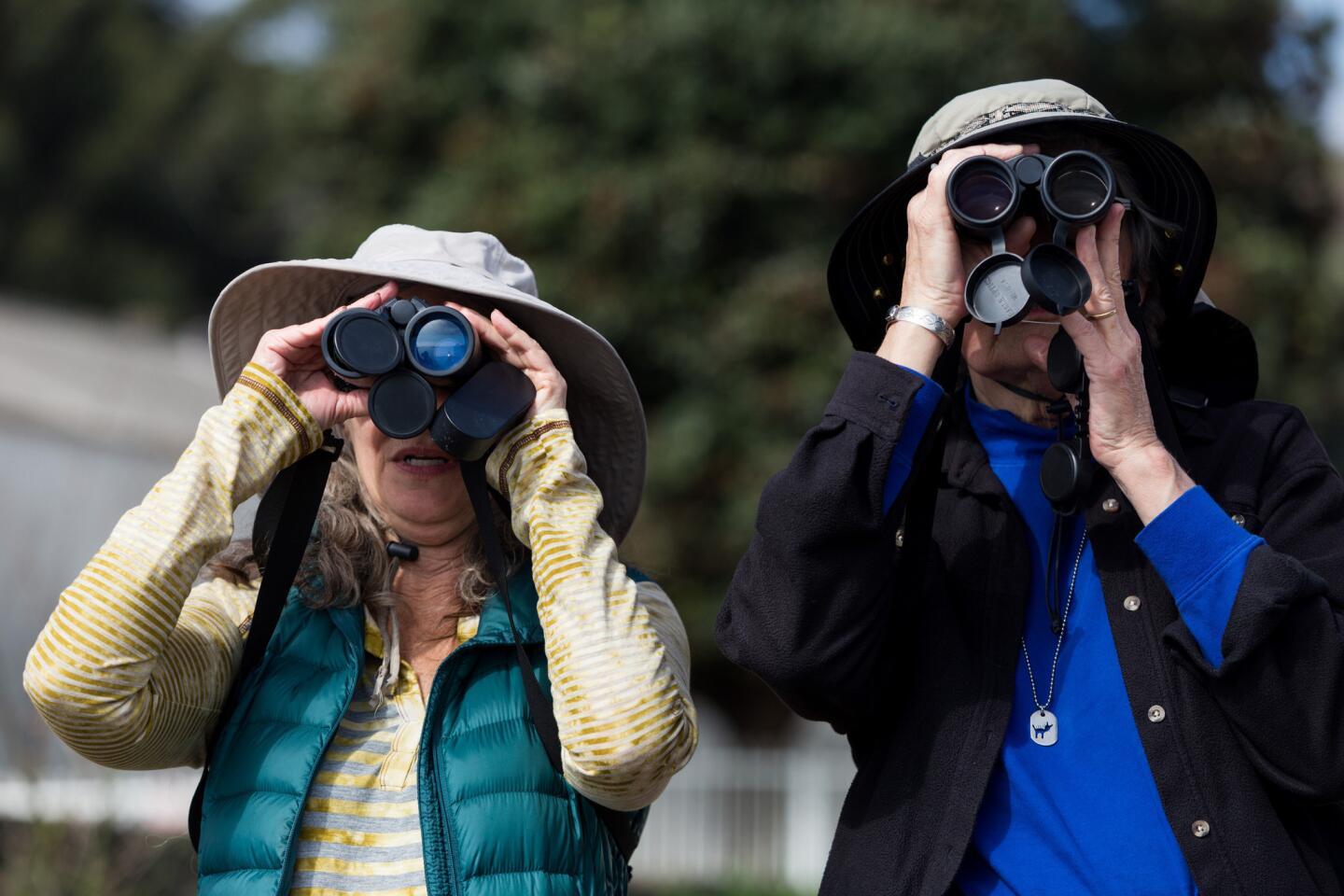As scientists work to identify mystery goo, rescued birds return home
- Share via
reporting from SAN FRANCISCO — The once-regal horned grebe scooted undignified around its box, a piece of printer paper stuck to the goo on its bottom. The seabird’s bold black and white feathers were a mucky brown; its wings matted with gunk, dirt and pebbles. A towel stuck to its belly had to be slowly peeled off like old duct tape.
Despite the bird’s pathetic appearance, Gummy Bear was Kathy Koehler’s favorite among the 323 goo-covered seabirds that the International Bird Rescue recovered from the beaches of San Francisco Bay last month.
“He was probably one of the worst contaminated birds that came in and the biggest fighter, which was why everybody liked him. He just had spunk,” the 62-year-old volunteer said.
More than a month after staff at East Bay Regional Park District discovered the birds floating offshore, scientists and wildlife officers are still trying to identify the mysterious goo that sickened and killed hundreds of the animals and to find whoever released the substance. While volunteers work to save birds like Gummy Bear and return them to the sea, scientists from as far away as Great Britain are examining the evidence on their feathers. And California police officers are tracking down tips that might help solve the mystery.
“[The birds] didn’t die in the natural world, they weren’t taken as part of hunting or fishing — these animals died just a horrific death,” said Capt. Paul Hamilton of the state Department of Fish and Wildlife. “Anyone who thinks they can just throw pollutants into the water is a criminal.”
East Bay Regional Park District workers found the birds Jan. 16 during a routine inspection and called the International Bird Rescue.
Neither wildlife officials nor the rescue group staff had seen anything quite like the sticky substance stuck to the birds’ feathers. It was odorless but had the texture of rubber cement. It had ruined the birds’ waterproofing, rendering them unable to regulate their temperature, stay afloat, find food or fly. It affected mostly surf scoters, buffleheads and horned grebes along the East Bay shoreline from Alameda south to Hayward. Many of them suffered from hypothermia, malnourishment and infections.
The Fairfield-based nonprofit International Bird Rescue took in more than 300 birds and so far has released 131 back into the San Francisco Bay. The group is still caring for 56 birds, and 139 died or were euthanized. The California Department of Fish and Wildlife found another 170 dead birds. More may have sank, fallen to predation or been otherwise missed by search teams, officials said.
No contaminated birds have been found since Jan. 22.
“At first, we thought it was going to be some kind of algal contaminant, but it didn’t look like that, and it didn’t smell like petroleum or anything, so it was really weird seeing the contaminant that was on them and not knowing, ‘What is this stuff?’” said Isabel Luevano, International Bird Rescue staff member.
David Crane, environmental program manager with the California Department of Fish and Wildlife’s Office of Spill Prevention and Response, said the goo is being tested at eight laboratories across the country. They are led by the Department of Fish and Wildlife, the California Department of Public Health, the U.S. Environmental Protection Agency and the National Oceanic Atmospheric Administration. Samples have also been sent to UC Davis and to a Plymouth University researcher in the United Kingdom who volunteered to help.
Feathers are usually sent as samples to allow the labs to extract the goo, Crane said. Each lab is performing different tests to help determine attributes of the substance, such as its mass, volatility and light absorption. Twice a week, scientists discuss the investigation in a conference call, sharing their findings in an effort to narrow down the possibilities.
State and federal scientists have so far determined that the goo contains a mixture of non-petroleum-based fats or oils, but there is still a ways to go to identify precisely what contaminated the water and hurt the birds. Crane said it could be anything, including synthetic oils such as silicone fluids, wood-derivative oils such as resin oils, or even animal fats.
“It is a material that is difficult to characterize, and that’s why we have so many labs working on it,” Crane said.
Non-petroleum-based substances are not covered by state spill response laws, and without a party to hold responsible, the International Bird Rescue has spent about $150,000 on food, medicine and cleanup.
A criminal investigation is also underway, led by Fish and Wildlife game wardens. There are about 400 game wardens statewide, and depending on the amount of information available, between two and eight officers are assigned to the mystery goo case each day.
Dressed in yellow Tyvek suits, the officers board inflatable Zodiac boats with GPS systems and nets to search for potential leak sources and collect samples for scientists.
It is still unclear, though, how much of the substance was dumped and whether it was intentionally released or spilled accidentally.
Hamilton said that investigators have received a few tips from the public, and wildlife officers are following leads. He declined to discuss the nature of the tips.
Whether accidental or intentional, illegal dumping can result in state and federal charges that carry severe fines or jail time.
Hamilton said prosecutors often consult wildlife officers about potential charges, and each dead bird could be considered a separate count.
“Maybe it’s going out on a limb, but I do think we’re going to find out who dumped this stuff,” Hamilton said. “When it comes to wildlife, there’s a close bonding there, and I think people that normally wouldn’t even get involved with law enforcement will come forward.”
As the scientists and police work to solve the mystery, the goo’s seabird victims continue their recovery. Volunteers gathered on a brisk, sunny Friday at Fort Baker near Sausalito, carrying birds in brightly colored plastic crates. At the water line, they tipped the boxes on their sides and opened the flaps. Just as Gummy Bear had the week before, the birds soared off toward the Golden Gate Bridge.
Koehler said watching birds like Gummy Bear leave is a happy kind of sadness. She recalled how the bird tried to bite her — as usual — when she opened the crate to set him free. Then Gummy Bear waded into the water, flapped his wings and shot out above the vast bay. Her “fighter” was gone.
“I hope I never see him again,” she said.
taylor.goldenstein@latimes.com
More to Read
Sign up for Essential California
The most important California stories and recommendations in your inbox every morning.
You may occasionally receive promotional content from the Los Angeles Times.
